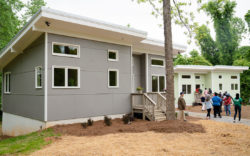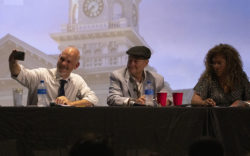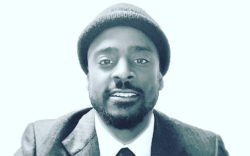Exacerbated by the enduring impact of 18 months of virtual learning, both Cedar Shoals and Clarke Central High Schools have weathered violent disruptions this year.
Incidents on Sept. 22 resulted in a hard lockdown and police presence at both schools. Kori Edmonds, a senior at Cedar, was late to second period. Traveling her normal route down the main stairway to class, fights broke out in the common area above. A mass of people rushed towards her and up the stairs, many filming videos she would see later on social media. Cedar’s shift towards incidents like this, she said, is associated with underclassmen being thrust into a high school ecosystem they are unprepared for.
“This year has been as chaotic as it has mainly because the senior class at Cedar is the only class that actually had one full year of schooling. Even the juniors under us technically did not finish a full year,” Edmonds said. “I think that lack of maturity and exposure to a normal high school environment has definitely created a shift in culture and a bunch of behavioral issues, and that culture has done things like encouraging fighting.”
With vulnerable and distressed students involved, conflict resolution efforts this year require sensitivity and diligence. Both new to Cedar, mental health counselor Kizzie Wingfield and behavioral specialist Cynthia Allen have implemented an approach to addressing conflicts: restorative circles.
Restorative practices are defined by the Georgia Conflict Center as “a movement oriented by a set of guiding principles that prioritize building community and connection, democratic participation and responding to harm in ways that embrace relationships, inclusiveness, support and accountability.” Headquartered here in town, GCC serves three Clarke County Schools—Whit Davis Elementary, Clarke Middle and Clarke Central—in addition to the greater community. The circle process is an integral part of addressing conflict in a restorative way, said Danny Malec, GCC’s executive director and a former principal in Washington, D.C.
“Kids don’t necessarily want to solve all their problems by fighting, but if that’s the tool that they have in their toolbox, that’s what they’ve learned in their community, that’s the tool they’re going to use,” Malec said. “If students know that at our school we circle up to solve problems, if they believe that it will be effective in them regaining respect or that there’s accountability through that process, students will start to choose it little by little. That’s the philosophy of restorative justice—let’s teach the skills and the tools so that we can widen our toolbox.”
According to Wingfield and Allen, restorative circles at Cedar have been very effective thus far. In a circle, they guide students through conversation about the issues and factors that led to their conflict and try to quell misperceptions, while providing a confidential space to express personal feelings and burdens.
“When we’re in a session, we can literally see the student’s mind and demeanor change. They’re more relaxed, they’re more open to hear from the other person. You can see that they have their own dialogue and aren’t able to communicate,” Wingfield said. “Initially everybody might be kind of quiet. But towards the end, the students are having a conversation, like ‘No, I didn’t say that I thought you said that,’ or ‘No, I don’t have a problem with you.’ At the end when we see the students smiling, laughing, we’ve even had students give each other a hug—those are the things we like to see.”
Allen always follows up with students post-circle to see if they need additional support. Circles are not limited to just peer and peer conflict. Wingfield and Allen have conducted restorative circles between a teacher and student and parent and student, and are open to expanding to any relationship where grief or conflict is present.
Much of the restorative work at Cedar is proactive to prevent fighting. Wingfield estimated that, nine times out of 10, a restorative circle is the result of a student approaching them with fears that a rising conflict will turn physical. To their knowledge, no student that participated in a circle has engaged in fighting at school since.
Restorative practices and traditional punishments aren’t mutually exclusive. Sometimes consequences, such as suspension, are necessary for the sake of safety, but Malec said they have no value in changing behavior without being supplemented with restorative practices. Circles and other techniques explore solutions that are sustainable and concrete.
“In restorative practices, if there’s going to be suspension, that’s fine, but we ask, ‘What are we doing to repair? What else are we doing around accountability and support for students, whether it’s violence or other things that lead to suspension? What other interventions are we putting in place to ensure support and accountability,’” Malec said.
Restorative circles don’t replace punitive measures at Cedar. They do prevent conflict, though, which in turn reduces suspensions. This is especially important at the Clarke County School District— according to a report by Richard Welsh of the University of Georgia on student discipline over 2015-18, in-school suspension (ISS) and out-of-school suspension (OSS) were the most frequent consequences. Students who are Black, male, homeless or with a disability were most likely to receive punishment. Black students were 50% of the student population, yet made up 80% of students disciplined over the period. Black male students, in particular, made up 52%, more than double their population. Additionally, they constituted 50% of lost instructional time from ISS and 55% from OSS.
Quelling physical arguments at Cedar, though, requires a culture shift. “I’ve talked to a lot of students and educators who say the behaviors we’ve seen this year we’ve never seen before. When I talk to the students, I do feel like they’re disconnected from Cedar Shoals, they don’t have that pride,” Allen said. “Adults who have graduated from here have a sense of pride, but students inside Cedar Shoals, I don’t think so.”
Edmonds has experienced conflict as ordinary throughout her time at Cedar, but finds herself especially resigned to it this year. “I’m not the type to go out of my way to run towards a fight or to pull up my phone and record and post it on social media. But to a certain extent, when it does happen, I’m not surprised,” Edmonds said. “It’s almost part of normal behavior just because of how frequently it happens. There’s been tons of times where I told people ‘Oh, there was just another fight when I was walking to class.’”
Restorative circles are not a quick fix. One of the long-term processes of a restorative approach to conflict is a commitment to culture change.
“I get from students that, ‘This is Cedar, that’s the way it is.’ But if the adults don’t take the first step of saying Cedar has such potential for excellence and we’re going to work on that together with our students, if you don’t involve students in solving the problems that everybody is experiencing, then you’re really not going to be able to change that culture,” Malec said. “That’s really the spirit behind restorative practices, is we have to share power amongst everybody—students, families and work together to make the situation better. Because if we’re just going to try to do this with the people at the top, the administrators, it’s going to be really challenging and likely not going to change that culture.”
Wingfield and Allen are starting Leadership Academy next semester, a pilot program that will teach The 7 Habits of Highly Effective Teens by Stephen Covey to freshman girls. In addition, they will be starting a monthly newsletter and increasing spirit events with the goal of reinforcing Cedar pride.
Allen and Wingfield are new, but they said they’ve already witnessed positive changes among students they work with. Circles build skills that go beyond just not fighting.
“Not only do they [students] get to talk to the person that they have a problem with, but they’re getting that skill on how to communicate to help them to make time when they’re angry or mad. If we teach them how to communicate effectively at this age, this is a skill that they will have for the rest of their lives, not only with their peers, but with their parents, coworkers or their relationship, building those skills to say, ‘You hurt me, this how I feel.’” Wingfield said.
With every participant in the circle, Allen tries to build a relationship that will hold them accountable. “What we give is the opportunity to talk things through, and then also at the same time we build a relationship with those particular students. We also talk about their goals and their aspirations. They know that ‘Hey, someone in this building has high expectations of me, so I’m expected to carry myself like a young lady or a young man. If I feel like I’m going through something, I have someone I can go talk to,’” Allen said. “Even though we have a lot of behavioral issues here, when I see students I see potential leaders, potential doctors, lawyers or whatever they want, they just need some guidance.”
Like what you just read? Support Flagpole by making a donation today. Every dollar you give helps fund our ongoing mission to provide Athens with quality, independent journalism.










